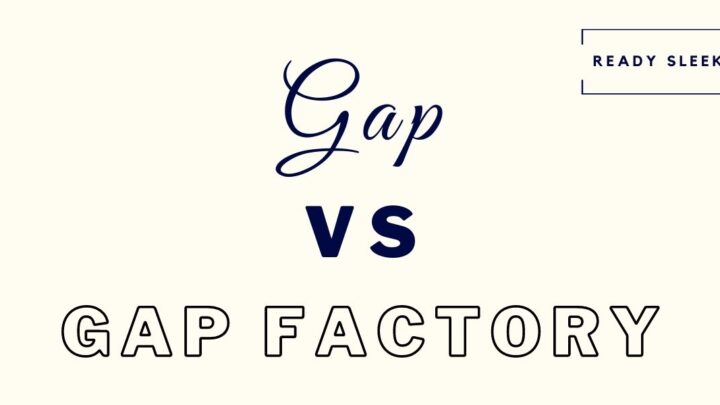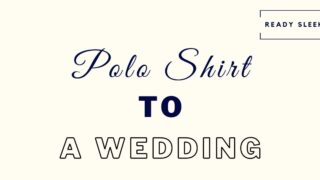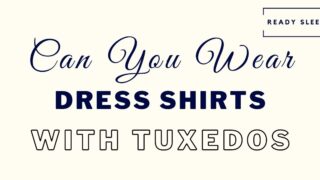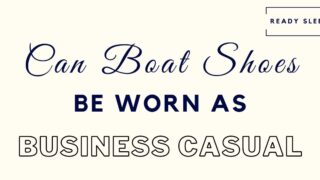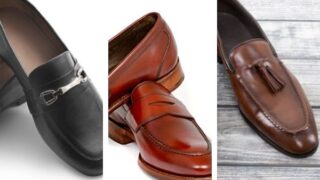You’re probably familiar with the brand Gap – it’s a common go-to when it comes to buying sweaters, jeans, and basics. But what is the difference between Gap and Gap Factory?
Gap and Gap Factory are separate fashion brands that have completely different clothing lines. Gap clothing is higher in price but uses higher quality materials, whereas Gap Factory clothing has a lower price point but the quality of their pieces is often lower as a result.
That’s a summary of the main differences.
In this article, I’ll discuss these differences between Gap and Gap Factory in more detail, and give you some tips on how to choose between them.
This article was written using independent research and is true only to the best of our knowledge.
Now, let’s get into it.
Gap Vs Gap Factory: 5 Key Differences
First things first, let’s discuss the main differences between Gap and Gap Factory.
1. They Are Separate Companies
Something that a lot of people don’t realize is that Gap and Gap Factory are actually two separate companies founded at different times.
Gap is an American clothing company founded in 1969 by Donald and Doris Fisher, whereas Gap Factory is a subsidiary of The Gap which was founded much later on, circa 1994 according to Gap’s own website.
So although these two brands share a similar name, they actually have a different history and operate slightly differently.
Both of these brands have both an online shopping presence as well as brick and mortar stores, although Gap stores are more common than Gap Factory stores.
2. Clothing Lines
Another difference between Gap and Gap Factory is that these two brands have different clothing lines.
Gap Factory is not a Gap Outlet in the traditional sense, in that it does not carry old Gap stock from previous seasons or Gap stock that has not passed quality control or is flawed for some reason.
Instead, its stock is specifically manufactured to be sold in Gap Factory stores and is made up of a different clothing line than what is sold in Gap stores.
This means that if you buy something at a Gap Factory store, it can only be returned at Gap Factory retail stores and not at other Gap stores, as they carry different stock.
The clothing line manufactured for Gap Factory is generally designed to be a more affordable yet still stylish version of Gap, however, it has a narrower range of products compared with the original Gap clothing line.
3. Price
As I just mentioned, the clothing lines for Gap and Gap Factory are different, and generally speaking, Gap Factory clothing is more affordable and budget-friendly compared with Gap.
For example, a pair of basic men’s jeans at Gap will set you back around 70-80 US dollars, whereas the equivalent jeans on Gap Factory will be more in the region of 40-60 US dollars. With a sale, you can get Gap Factory jeans even cheaper than this.
In addition, shirts sold on Gap Factory cost around 40-50 US dollars pre-sale, and can go down to 20-25 dollars during a sale.
On the other hand, shirts on Gap itself will generally cost around 60 dollars, with the more expensive pieces going up to 80 dollars in price.
This lower price point is what Gap Factory tends to be known for, and people who prefer to shop at a lower cost often choose Gap Factory over Gap for this reason.
4. Labeling
A more minor and perhaps less noticeable difference between Gap and Gap Factory is how each brand labels its clothing.
This is most noticeable when jeans from each clothing line are compared.
Gap Factory jeans usually have a horizontal label with the words ‘Gap Denim’ on the inside. Sometimes the label will also say ‘Gap Factory’ instead.
Gap jeans, on the other hand, usually have a square label with the traditional Gap logo on them. Some of the Gap range jeans also simply have the word Gap printed directly onto the inner waistband of the jeans.
Additionally, the jeans from Gap Factory usually don’t have a leather back patch over the right hip. However, this is a feature that is commonly found on Gap jeans.
These differences are quite minor overall, however can be useful if trying to tell the difference between jeans from each brand when shopping in a thrift store, for example.
5. Quality
Another difference between Gap and Gap Factory is the quality of the garments manufactured for each brand.
Because Gap Factory is specifically designed to be more budget-friendly and affordable, this also means that the quality of clothing tends to be lower compared with Gap products.
The old adage ‘you get what you pay for’ does generally apply here.
Although you can find great-looking clothes from both brands, Gap Factory on the whole uses cheaper materials and so you can expect that their clothing has a shorter lifespan and is more susceptible to damage during wash cycles.
For instance, you won’t find any selvedge denim jeans at Gap Factory, whereas you can find these at Gap.
This is because selvedge denim is a premium quality denim material that is more expensive to produce than regular denim.
Additionally, you can expect that the stitching and fastenings that Gap Factory clothing is made with are of a lesser quality compared with those found on Gap clothing.
The savings made from using cheaper materials and manufacturing techniques is what makes Gap Factory more affordable than Gap, and for the cash-strapped consumer, this is an opportunity to buy on-trend clothing without the big price tag.
However, it does mean that you have to sacrifice some quality.
Gap Vs Gap Factory: How To Choose
Now you know the main differences between Gap and Gap Factory. But how do you choose which brand to shop from?
Let’s discuss some factors you should consider before taking the plunge.
1. Budget
When it comes to budget, the clear winner when choosing between these two brands is Gap Factory.
As I mentioned before, Gap Factory’s clothing line has been specifically designed to be affordable and budget-friendly, whilst still giving customers contemporary, fashionable clothing.
The lower price point of garments sold by Gap Factory means that your dollar will go further when shopping here.
So if your number 1 priority is sticking to your budget, then it’s best to choose Gap Factory.
2. Longevity
An important factor to consider when choosing between Gap and Gap Factory, but also when shopping for clothing in general, is to consider how important the longevity of your clothing is to you.
Some people prefer to prioritize longevity over price, knowing that they will get more wear out of their purchase, even if the initial cost is higher.
If you are one of these people, then shopping from Gap will be more suitable for you, as you can expect a certain level of quality when it comes to their garments.
As I’ve already mentioned, Gap clothing tends to be made of higher quality material and therefore is likely to have better longevity.
Gap Factory garments, on the other hand, are made more cheaply and of cheaper materials, therefore they’re unlikely to last as long as Gap clothing before signs of wear and tear become visible.
3. Selvedge Denim
Another deciding factor when choosing between Gap and Gap Factory is whether or not you’re specifically looking for some selvedge Denim jeans.
Selvedge denim is a premium quality denim that is less likely to fray and tear over time compared with regular denim.
As a result of this, it also tends to be more expensive.
Gap Factory does not sell selvedge denim jeans, mostly because they are expensive and hence wouldn’t suit the lower price point that Gap Factory products are known for.
So, if you’re hunting for selvedge denim jeans specifically, then Gap clothing is the choice for you, as Gap Factory simply doesn’t stock these types of jeans.
4. Range
For some people, the shopping experience itself is important as well as the end result.
Having a large range of styles and designs to choose from is therefore important to some people who want to spend time browsing before they decide on their final purchase.
If this resonates with you, then you may prefer to shop at Gap over Gap Factory.
Gap has a larger range of different clothing styles and designs compared with Gap Factory, which tends to have a more limited clothing line.
This isn’t to say that you won’t be able to find something to your liking at Gap Factory, simply that you will have more options to choose from if you shop at Gap.
Conclusion
I hope after reading this article that you now understand more about the differences between Gap and Gap Factory.
Both are great staples for everyday fashion basics that are sure to be on-trend, so whichever you decide to shop at you’re sure to find something you like.
Ready Sleek founder. Obsessed with casual style and the minimalist approach to building a highly functional wardrobe. Also a fan of classic, vintage hairstyles.

